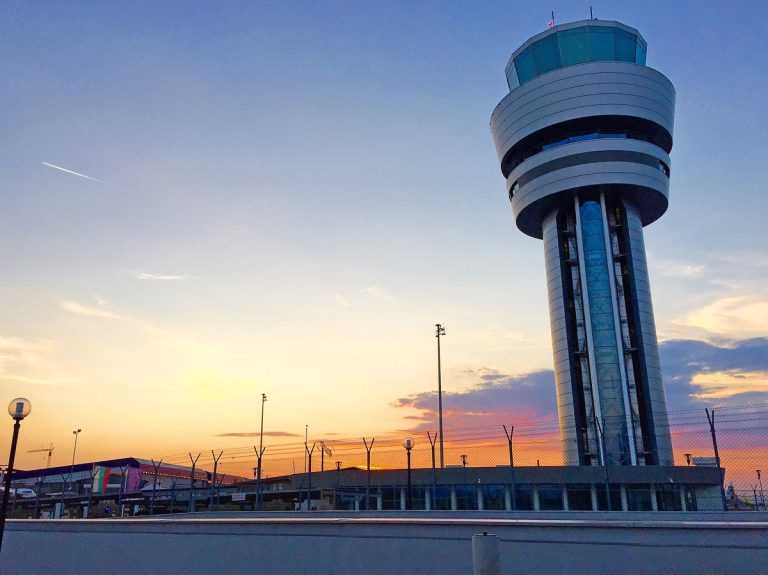

Spartan College of Aeronautics and Technology is a prominent voice in the aviation space. These blogs are for informational purposes only and are meant to spark discussions within the aviation industry on a variety of topics.
If you’re interested in a future in the aviation industry, there are many paths you can take. One of the most exciting and fulfilling is becoming an air traffic controller. Air traffic controllers are key players in the process of ensuring that air travel happens smoothly and that all pilots, passengers, and crew members remain safe when they fly. If you are interested in becoming involved in the aviation industry and think that air traffic control might be the right field for you, read on. You can learn what an air traffic controller is, what steps you need to take to become one, and what possible paths you can expect to take once you've completed all the necessary training to become an air traffic controller.
Air traffic controllers are the professionals in charge of directing airplane traffic in the air and keeping all aircraft and people inside them safe. Air traffic controllers have extensive training learning how to direct multiple planes to their destinations safely — at the same time). They can work in one of three locations: in a glass room in the control tower at the airport, in a control center not located at an airport (there are 24 across the US), or in a radar room that is also located in a control tower at an airport.
Air traffic controllers are the directors of traffic in the sky. They ensure that all flights taxi, take off, fly, and land smoothly wherever they're going. They work on ensuring that multiple planes can fly safely at once. It is a zero margin of error job, which means that no air traffic controller can make mistakes — the stakes are too high. For that reason, the training to be an air traffic controller is intensive, and the minimum requirements to be accepted into training are plentiful. Air traffic controllers don't just sit in a glass tower and help direct planes when they take off, even though that's when most passengers encounter or see air traffic control. Here is a list of more things that air traffic controllers do on the job:
At any moment, there are more than 14,000 air traffic controllers working to direct traffic in the sky and at airports. In order to become one of them, you need to go through the necessary education and training so you are prepared to do this intense, serious work. In order to actually work in the field, you must complete the required training courses at the Federal Aviation Administration (FAA) academy in Oklahoma City, OK. Here are the minimum requirements to be accepted to the FAA training academy so you can eventually work as an air traffic controller, as well as the training steps you'll have to go through in order to be prepared to hold the job.
To become an air traffic controller, below are the minimum requirements to work in the United States.
If you meet the above requirements to complete the required FAA training course, then you may be considering pursuing this as a professional path. If you decide you want to become an air traffic controller, here’s what your path may look like:
Congrats! You've completed the FAA Air Traffic Control Training Program. Now you are ready to control air traffic in the real world and begin working in aviation.
The FAA is the main air traffic control employer in the country, and they'll have a variety of jobs available for different experience levels throughout the country. You will most likely have to move wherever the FAA places you. The FAA announces job openings once a year for a limited window, so be prepared to apply then.
Working as an air traffic controller is a very specialized, unique job. Here are some answers to frequently asked questions about the work, so you can know what you're getting into before deciding whether or not this path is the right one for you.
Yes, the FAA requires you to apply for air traffic controller training before your 31st birthday. They also require you to retire at the age of 56. The one exception to the above limits is that former military air traffic controllers are allowed to begin work with the FAA even if they are older than 31.
Yes, there are always air traffic controllers at work. However, this does not necessarily mean that you will work overnight. At large facilities and in high traffic areas, there are day, evening, and night shifts, as well as shifts that are specialized for holidays and weekends. So, you may end up working whatever schedule is best suited for you. If you work at a smaller facility or lower traffic area, your hours may be more aligned with dawn to dusk (if airports only fly planes during the daylight hours).
Being an air traffic controller is not for just anybody. Someone well-suited to be an air traffic controller has:
Now that you know what being an air traffic controller entails and what steps you need to take to become one, and you think it's a job that you're well suited for, consider beginning your path to studying air traffic control.
While Spartan College doesn’t offer this program, we invite you to explore other aviation-industry training that we offer. Click here to learn more about our programs.
Affiliate Partner Program | Jobs at Spartan | Privacy Policy | Opt-out Policy | Privacy Notice - California Residents| Notice of Non-Discrimination | Website Accessibility Help | Transparency in Coverage Act
© 2024 SPARTAN COLLEGE OF AERONAUTICS AND TECHNOLOGY. ALL RIGHTS RESERVED.